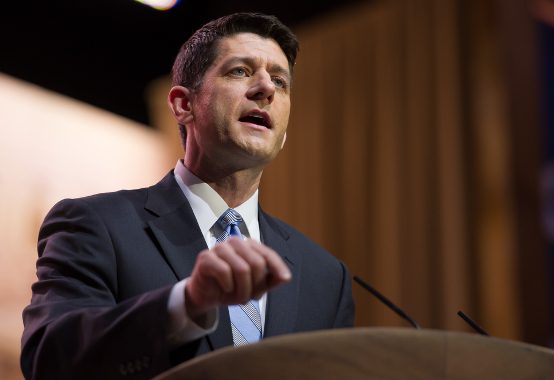Development of Non-Toxic 2016 GOP Agenda Continues Apace

The release of Rep. Paul Ryan’s anti-poverty “discussion draft” last week marks another milestone in a long, painstaking, and necessary project: the development of a non-toxic policy agenda on which the next Republican presidential nominee can run.
Zooming out, we see Republicans, like Tiktaalik, slowly transitioning out of the primordial soup of supply-side dogma. There was Rep. Dave Camp’s comprehensive tax reform proposal. It’s revenue neutral and maintains progressivity. Relatedly, Ryan takes care to insist his own proposal is “not a tax cut.” It’s true the conservative movement didn’t exactly leap for joy at Camp’s proposal—and there’s a myriad of reasons to doubt that the GOP could ever muster the courage to eliminate as many loopholes and deductions as it would take to reconcile the math of the Ryan budget.
But the larger point is this: a net tax reduction for the rich is now a radioactive position on the mainstream right.
Climbing down the income ladder, Ryan, in presenting his anti-poverty plan, with its devolution to states and consolidation of public assistance spending, noted that “this is not a budget-cutting exercise.” Yes, there’s the matter of reconciling these reforms with the harsh math of the Ryan budget. And the “accountability standards” to which states and local agencies would be held smells an awful lot to me like the anti-poverty version of No Child Left Behind.
But—and again—the larger point is this: a net reduction in spending on the poor and vulnerable is now a radioactive position on the mainstream right.
The recovery from “The 47 percent” and “You built that” will remain a tough slog over the next 18 months. However, the momentum is clearly in the direction of rational reform. The Tea Party era—in which “conservatism” for all practical purposes stood for an unholy alliance of plutocracy and Dixie revanchism—is clearly coming to a close.
Just how the all the manic energy of the last five years will be brought into the fold of a plausible governing agenda remains to be seen. The Room to Grow agenda represents the seedbed of ideas that might eventually become an appealing campaign platform. I like, in particular, Andrew Kelly’s ideas on higher-ed and job training, and Carrie Lukas’s emphasis on fiscal reforms that improve work-life balance.
Broadly speaking, the “reformocon” carriage is an interesting one, fraught with tension but full of possibility: that of the nontechnocratic wonk; of superintendence of the welfare state in a pro-market direction. Of bottom-up or middle-out reforms that issue from the top. The idea of a Medicare premium support system is qualitatively different than, say, Ronald Reagan’s original position on Medicare. But if the arrow is pointing in a rightward direction, can each faction of the right buy into it? Can you sell the idea of “reform” to people on a steady diet of Mark Levin, Ted Cruz, and Sarah Palin? Personally, I think the right would be better off it admitted—no, more than admitted—that “spontaneous order” does not and will not ever lead to a safety net or social insurance for the elderly.
But perhaps I worry too much. One of my themes in this space is the belief that the Tea Party was a cultural temper tantrum more than a granular programmatic shift. It may turn out that tea partiers can be lead to the water of an essentially neoconservative domestic agenda more easily than anyone currently imagines.
Comments